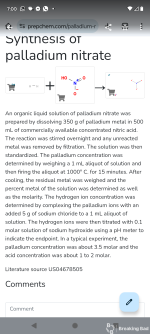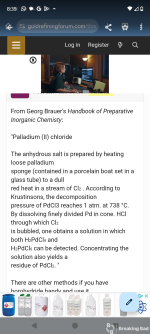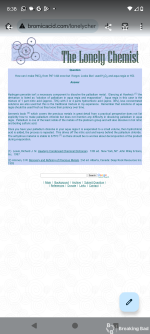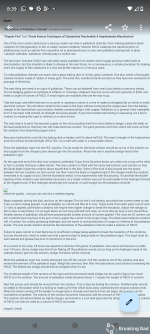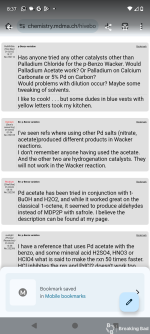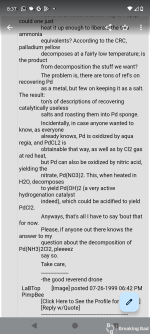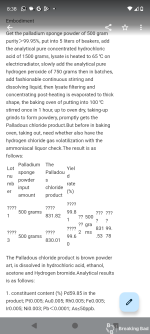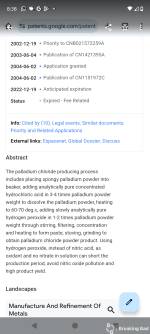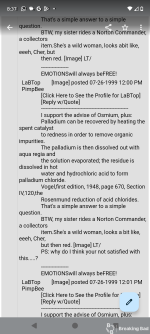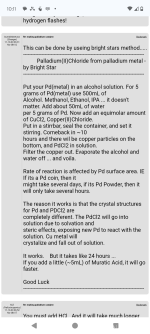Preparation of Palladium Chloride" via electrochemistry
"Chapter Five" from "Uncle Festers Techniques of Clandestine Psychedelic & Amphetamine Manufacture"
One of the most useful substances a serious cooker can have is palladium chloride. From making palladium black catalysts for hydrogenation, to the so called "wacker oxidation" wherein PdCl2 catalyses the transformation of allylbenzenes such as safrole from sassafras oil to phenlyacetones, to your own palladium plating bath to plate "catalytic cathodes," palladium chloride plays a central role.
The last time I checked, PdCl2 was still pretty easily available from outlets which supply precious-metal salts to electroplaters, but this situation is likely to change in the near future. As a consequence, a simple procedure for making one's one supply of this substance in a very low-profile manner is of obvious value.
To make palladium chloride one starts with a glass baking dish or similar glass container. One also needs a thoroughly cleaned condom made of rubber or sheep guts. The extra thin, sensitive brands are best as they have less resistance to passage of electricity.
The next thing one need is an ingot of palladium. These can be obtained from one's local dealer in precious metals. (You're hedging against an outbreak of inflation or monetary collapse!) One troy ounce will cost upwards of $240, and make a couple of ounces of PdCl2. If small ingots are available, they are the way to go.
Take the ingot, and either hammer on a corner or squeeze a corner in a vise to make an elongated lip on which to make electrical contact. This will allow contact to be made to the ingot without immersing the copper jaws from the battery charger in the hydrochloric acid solution, thereby contaminating it with copper. Palladium is, in general, fairly malleable, but if it has been cold-worked, its strength increases greatly. If you have trouble hammering or squeezing out a lip for contact, try heating the ingot to redness on a stove burner.
The next step is to paint the exposed copper on the red or positive lead from one's battery charger. Leave the teeth on the lead unpainted so that they can still make electrical contact. The paint prevents acid mist, which will come up from the solution, from dissolving copper into it.
Now pour hydrochloric acid into the baking dish or beaker until it's about half full. The exact strength of the hydrochloric acid isn't critical, but lab-strength (35%) HCL cut in half with water is a reasonable choice.
Place the palladium ingot into the HCL solution. The lip made for electrical contact should be up out of the solution so that copper from the charger's jaws doesn't get into the solution. Attach the red or positive charger lead to the palladium ingot.
On the opposite end of the dish, two condoms, preferably Trojan Extra Sensitive brand, are rolled one on top of the other to form a double thickness rubber barrier. The inner condom is filled with the same hydrochloric acid solution so that the liquid depth inside the condom about equals that in the dish. Some of the acid is also poured into the space between the two condoms so that current can flow. Insert the black or negative lead of the charger inside the condom, immersed in its supply of acid. See the illustration below. In my experiments with this process, I found that the double layering of the condoms was absolutely necessary, as a single condom was just too permeable to the hydrogen formed at the negative pole. If this hydrogen should get into solution, it could sludge out the palladium chloride.
check the quality... now you can see why it needed retyping
Begin magnetic stirring the dish, and turn on the charger. First try the 6 volt setting, and check the current meter to see if any current is being passed. In all probability, no current will flow at 6 volts. Trojan Extra Thins don't pass current until 12 volts is applied, and thicker condoms will require even higher voltage to break the insulation. Adjust the voltage so that a slow current flows. For an ingot about an inch long and half inch wide, no more than an amp or two should flow. Smaller pieces of palladium should have proportionally smaller amount of current applied. This must be DC current, not AC! A transformer may have to be put in line to adjust the current to the proper range. The black lead inside the condom will, of coarse, fizz crazily, producing hydrogen, but one wants to avoid production of oxygen or chlorine at the palladium anode. The sole anode reaction should be the dissolution of the palladium metal to make a solution of PdCl2.
Failure to pass current is most likely due to insufficient voltage being applied to break the insulation of the condoms, but one should also check to make sure that a good contact is being made on the palladium ingot. This ingot must be well cleaned and grease-free prior to immersion in the acid.
At a current of one amp, 54 hours are required to dissolve 106 grams of palladium. One ounce will dissolve in a little over 14 hours. Some sludge may form from flaking off the palladium anode, but so long as the hydrogen made at the cathode doesn't get into the solution, sludge formation will be minimal.
When the palladium ingot has mostly dissolved, turn off the current. Pull the condoms out of the solution, and also remove the remnant of the palladium ingot. Weigh this remnant, then filter the hydrochloric acid solution containing the PdCl2. The filtered out sludge should also be weighed when it's dry.
The combined weight of the remains of the ingot and the recovered metal sludge can be used to figure how much PdCl2 is in the solution. The amount of palladium metal dissolved times 1.7 equals the weight of PdCl2 in solution.
Next the excess acid should be removed from the solution. This is done by boiling the solution. Distilled water should be added to the beaker while it is boiling to make up for that which boils away, maintaining the original solution level. When the steam coming off the beaker no longer gets a strongly acid reaction from pH paper, the process can be considered completed. The volume of the solution should be measured, and the amount of PdCl2 per ml calculated. The solution should be bottled up, tightly stopper, and stored in a cool dark place like the refrigerator. The water solution of PdCl2 can then be used as a source of PdCl2 and water.
retyped ; toledo

